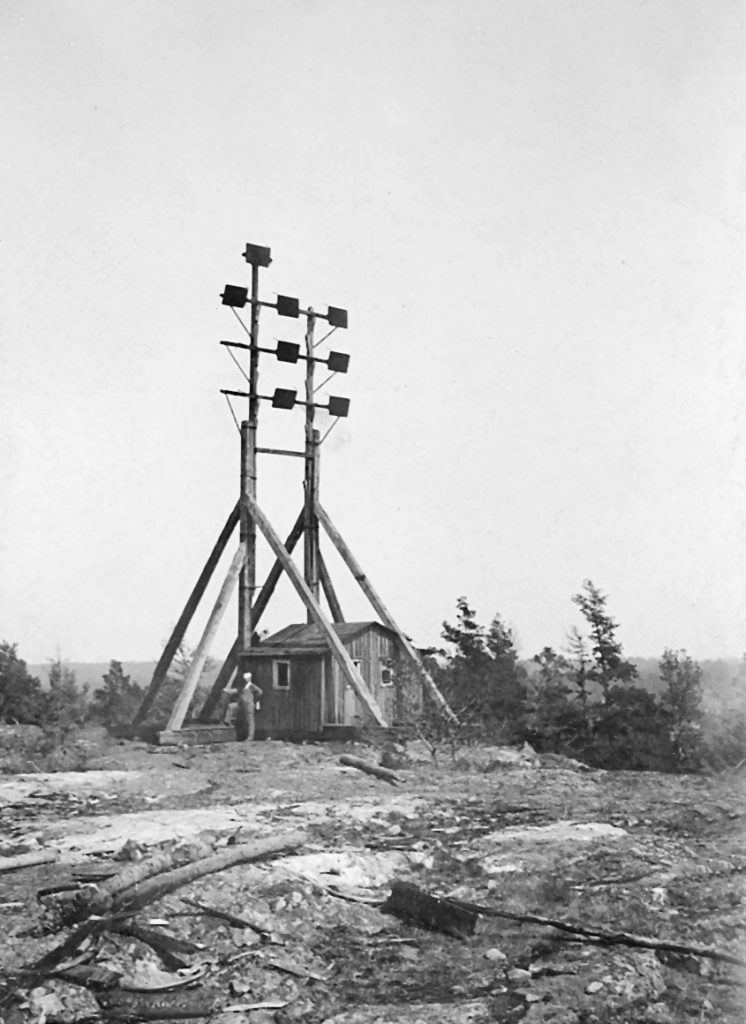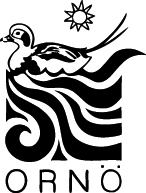· Start · Next sign · Previous sign · Swedish
ORNÖ FIBER – FROM BEACON HILL TO FIBRE NET
Look out into the bay. When the waters are calm, you can discern a black line along the bottom. That’s a fibre cable and part of Stockholms skärgårdsnät that supplies thousands of households with fixed broadband on Ornö, Runmarö, Nämdö and Harö.
History is full of its predecessors: beacons, optical telegraphs and good old telephone lines.
Communication with the rest of the world has always been essential for people living in the archipelago. In uncertain times, above all it was important to warn against enemies. The Law of Uppland, dating from the 1200s, governed how the alarm should be sounded using fires – beacons – also called “böte”. The beacons were raised on rocky islets or on a headland, from which the enemy could easily be sighted, on high ground where the fire was easily visible to the next beacon. In times of unrest, the population took turns standing guard and lighting the fire when enemy ships were sighted, or another beacon was lit. That way, the alarm could be sent from the outer archipelago all the way to Stockholm. These places are called beacon hills, or “bötsberg”. The Ornö islands abound with names that bear witness to the locations of the beacons, such as Sandböte, Genböte and Kasudden.
In the 1790s, the optical telegraph was introduced. As with the beacons, the aim was to send messages via a chain of locations with an unobstructed view. The invention was originally French. However, a Swede, inventor A.N. Edelcrantz, developed an improved and faster version.
It consisted of ten collapsible iron shutters used to form different combinations that were decoded by the telegraph operator at the next station.
During the Finnish War against Russia in 1808-1809, a network of optical telegraphs was established along Sweden’s east coast, from Landsort via Stockholm to Gävle. On Ornö, the telegraph was placed on the highest point on the island, the old Beacon Hill (Kasberget) in Brevik, which is now called Telegrafberget. The telegraph on Ornö sent messages via Dalarö and Dalarö fort, or south via Älvsnabben outside Muskö.

Ornö optical telegraph at Telegrafberget in Brevik. The photo was taken in 1905. Today, a lookout tower, well worth a visit, has replaced the telegraph.
After the war, this network was discontinued, but was restored between 1834 and 1876. During this period, private persons could also send telegrams. Here is an example of a message sent from Ornö:
14 April at 10 am sent to Emelie Blomberg Styrmansgatan 32, Stockholm. Anna dead. Three children sick. Hilma close to death. Christina childbirth soon. Come immediately. Hultgren
In the 1880s, the telephone was introduced in Sweden. Work on laying the telephone cable to Ornö began in autumn 1892.
Sundby gård and the rectory were among the first to have their own telephone installed, in 1897 and 1911, respectively.
Not until the 1940s did it become more common to own a telephone. As the mobile network and the fibre network are now being installed, the old telephone lines are being dismantled in many parts of the island. Today, a fixed telephone line has to rely on IP telephony, with the help of Ornö fiber and Stockholms skärgårdsnät.
Lervassa Trail was produced by Ornö Museum in collaboration with Stockholms läns Hembygdsförbund and with funding from the Swedish National Heritage Board.

